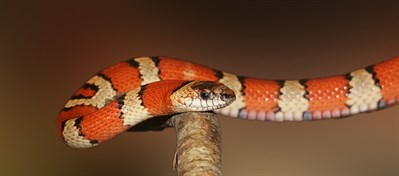When The Snakes Come Marching In
Winter is gone, spring is finally here and most of us cannot wait to get outdoors and explore what nature has to offer! Springtime weather in Texas is perfect for hiking, trail riding, water skiing, fishing, and floating the river. During these activities, we need to be especially careful about the snakes that have been hiding away all winter long, because they also want to come out for some fun in the sun!

“Once the days get up to the high 70’s to low 80’s, the snakes that “winter” in more shallow quarters will start moving” said Teresa Shisk-Saling RVT, Veterinary Technician at the Texas A&M College of Veterinary Medicine & Biomedical Sciences. “This includes king snakes, rat snakes, milk snakes, among others. The snakes that hibernate deeper down in burrows, pits, and dens, will start moving after the ground around them warms up; this group most notably includes the rattlesnake. The first thing they start looking for is food and water. Once they shed their skin, they will be looking for a mate.”
If you are hiking or camping, be careful where you sit. If you want to sit down on a downed tree or old log, check it out first. Be careful of even stepping over a downed tree or old log, because there might be a snake on the other side; snakes like to hang out in places they can hide. Typically, if you find a snake in a tree, it is non-venomous. Although, be careful of low-lying branches of trees near the water, because water moccasins like to hang around those areas.
“Watch out when you are moving rocks or rock climbing, of where you put your fingers. If you are clearing up an area or clearing up trash, snakes like to hide under sheet metal (tin) or old boards and siding” said Shisk-Saling.
If you do come across a snake in the woods, fields, rivers, lakes, or rocks, you can admire it and even take its picture, but leave it alone! Rat snakes, Hognose snakes, and king snakes are beautiful to look at, but you are doing more harm to them than good by deciding to take them home with you.
“This time of year (in Texas) the king snakes, milk snakes, rat snakes, hognose and garter snakes are all moving around (these are non-venomous snakes)” said Shisk-Saling. “However, copperheads and water moccasin will be out soon. If you are boating or fishing and see a snake’s entire body swimming on top of the water; that is a water moccasin. Non-venomous snakes will swim in the water.”
The great state of Texas is home to 37 different species of snakes, and surprisingly, only four of those are venomous. The Texas rat snake is the most commonly seen snake in the state.
Despite the fact that snakes are not everyone’s favorite wildlife species, they do serve a purpose. In places where people have killed off all the non-venomous snakes, then the venomous snakes will move in. If you then kill off the venomous snakes, the reason they were around becomes apparent, usually rodents will be everywhere, since you have killed off their predator.
“If you have problems with snakes, they are usually looking for water or food” said Shisk-Saling. “Clean up any wood piles, trash, building material, or anything that rodents might find usable for housing. It is helpful if you create “water-stations” in certain areas, away from you, but where the snakes can reach them. Just use shallow pans, or even litter boxes, kept full of water, to keep the snakes happy and away from potential damage.”
Pet Talk is a service of the College of Veterinary Medicine & Biomedical Sciences, Texas A&M University. Stories can be viewed on the Web at vetmed.tamu.edu/news/pet-talk. Suggestions for future topics may be directed to editor@cvm.tamu.edu.


